Infant Formula: Nutrition & Development
VerifiedAdded on 2020/05/28
|13
|3439
|127
AI Summary
This assignment delves into the crucial topic of infant formula nutrition, particularly focusing on its effects on the development of preterm infants. It examines various aspects, including the composition of infant formulas, their potential benefits compared to breast milk, and the ongoing challenges in replicating the complex nutritional profile of human milk. The analysis is based on a selection of research articles that shed light on the latest scientific understanding of this important subject.
Contribute Materials
Your contribution can guide someone’s learning journey. Share your
documents today.
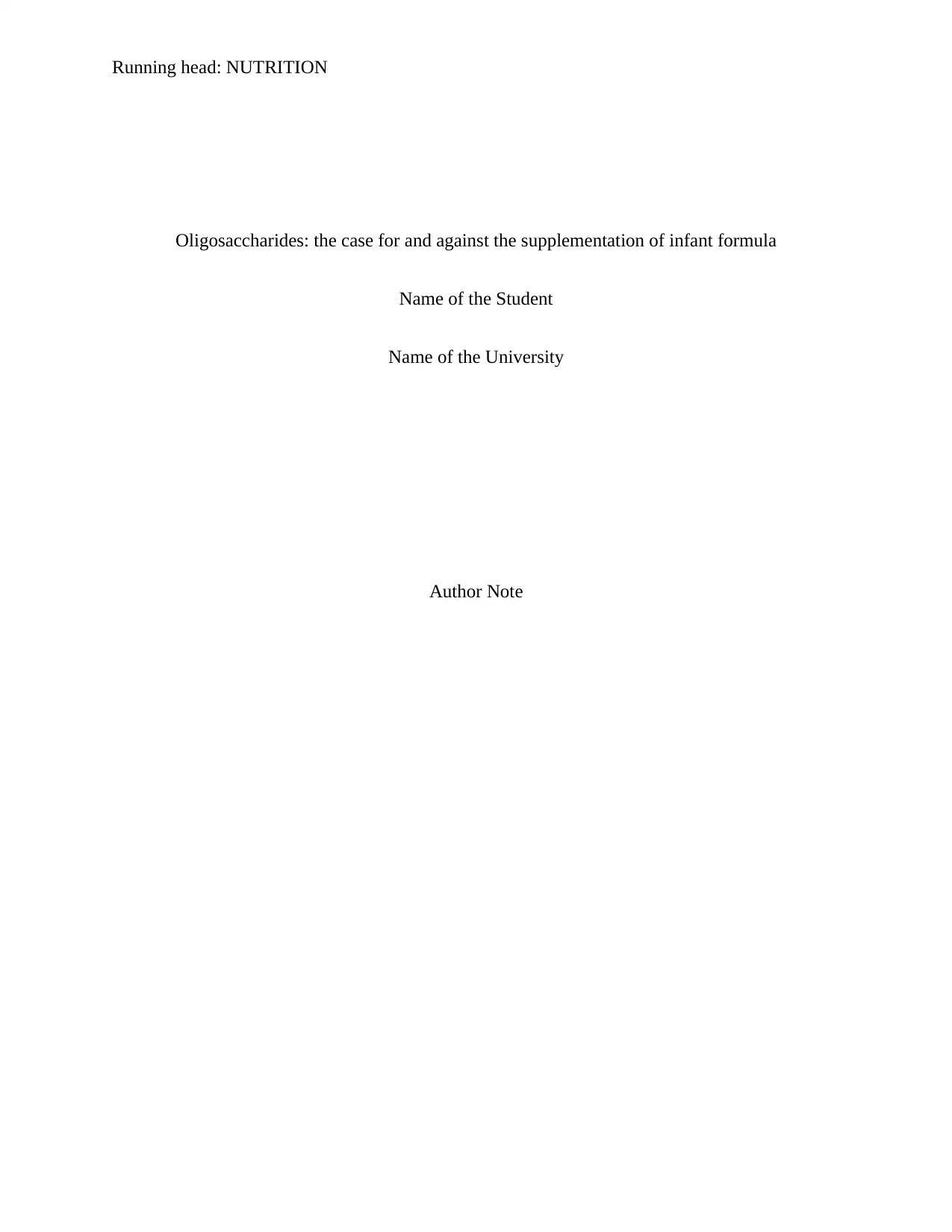
Running head: NUTRITION
Oligosaccharides: the case for and against the supplementation of infant formula
Name of the Student
Name of the University
Author Note
Oligosaccharides: the case for and against the supplementation of infant formula
Name of the Student
Name of the University
Author Note
Secure Best Marks with AI Grader
Need help grading? Try our AI Grader for instant feedback on your assignments.
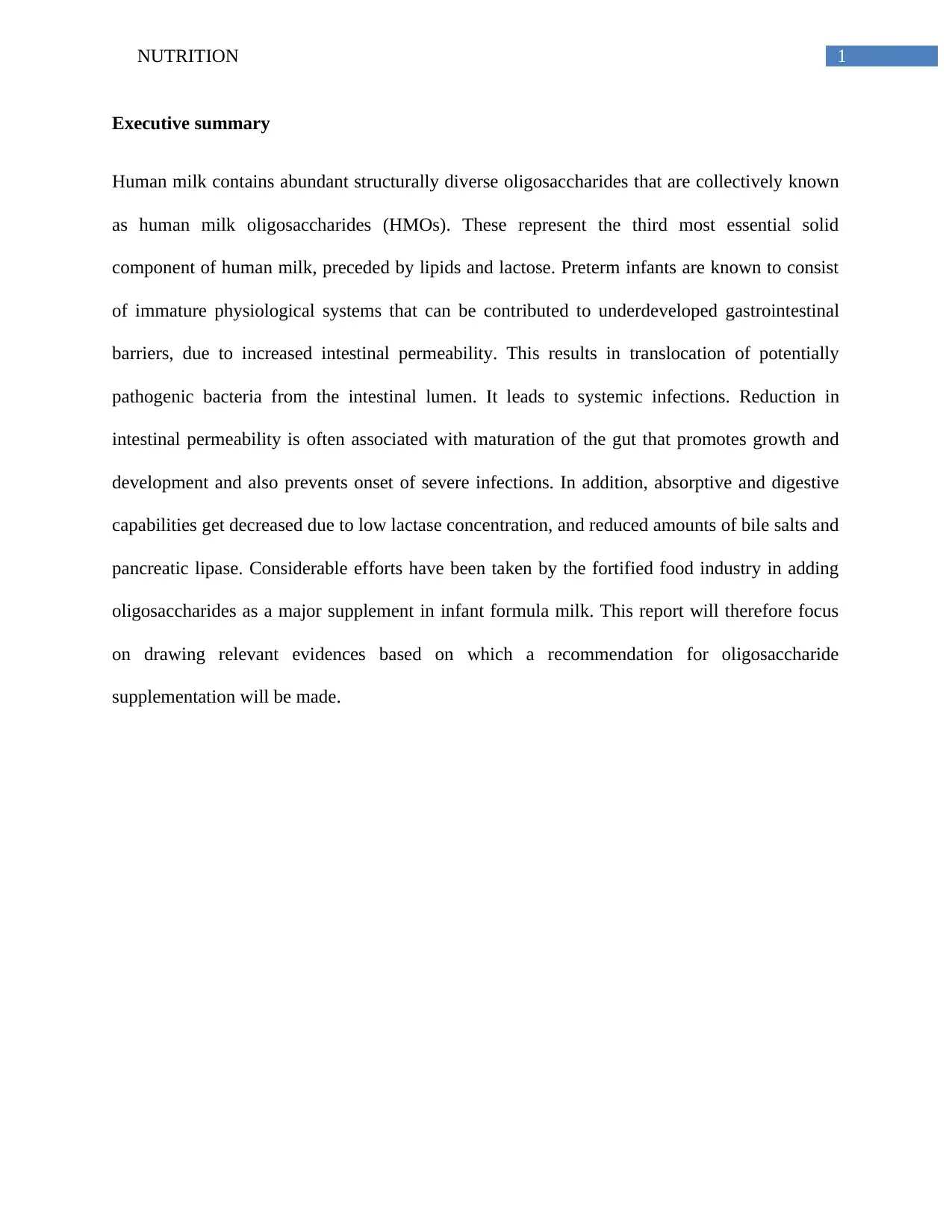
1NUTRITION
Executive summary
Human milk contains abundant structurally diverse oligosaccharides that are collectively known
as human milk oligosaccharides (HMOs). These represent the third most essential solid
component of human milk, preceded by lipids and lactose. Preterm infants are known to consist
of immature physiological systems that can be contributed to underdeveloped gastrointestinal
barriers, due to increased intestinal permeability. This results in translocation of potentially
pathogenic bacteria from the intestinal lumen. It leads to systemic infections. Reduction in
intestinal permeability is often associated with maturation of the gut that promotes growth and
development and also prevents onset of severe infections. In addition, absorptive and digestive
capabilities get decreased due to low lactase concentration, and reduced amounts of bile salts and
pancreatic lipase. Considerable efforts have been taken by the fortified food industry in adding
oligosaccharides as a major supplement in infant formula milk. This report will therefore focus
on drawing relevant evidences based on which a recommendation for oligosaccharide
supplementation will be made.
Executive summary
Human milk contains abundant structurally diverse oligosaccharides that are collectively known
as human milk oligosaccharides (HMOs). These represent the third most essential solid
component of human milk, preceded by lipids and lactose. Preterm infants are known to consist
of immature physiological systems that can be contributed to underdeveloped gastrointestinal
barriers, due to increased intestinal permeability. This results in translocation of potentially
pathogenic bacteria from the intestinal lumen. It leads to systemic infections. Reduction in
intestinal permeability is often associated with maturation of the gut that promotes growth and
development and also prevents onset of severe infections. In addition, absorptive and digestive
capabilities get decreased due to low lactase concentration, and reduced amounts of bile salts and
pancreatic lipase. Considerable efforts have been taken by the fortified food industry in adding
oligosaccharides as a major supplement in infant formula milk. This report will therefore focus
on drawing relevant evidences based on which a recommendation for oligosaccharide
supplementation will be made.
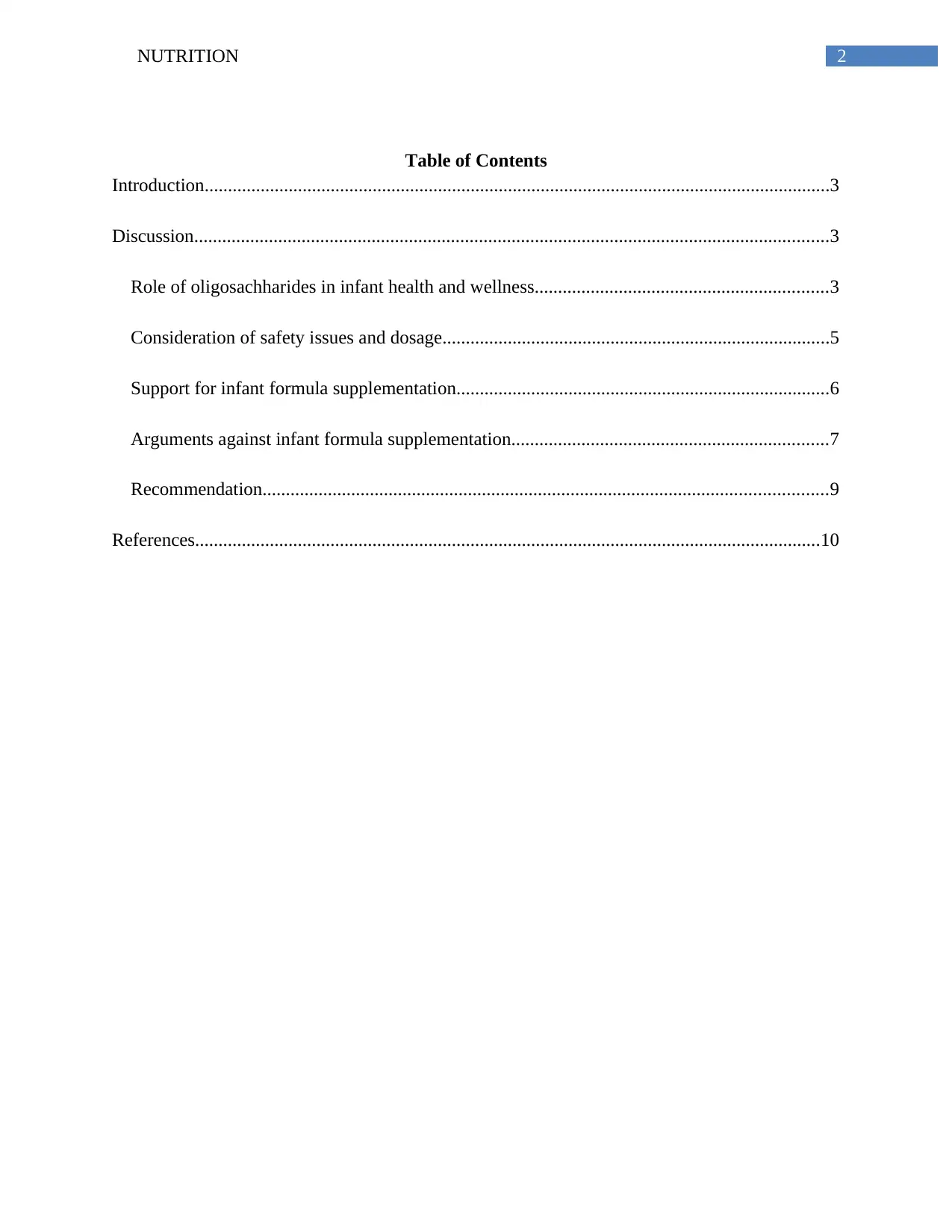
2NUTRITION
Table of Contents
Introduction......................................................................................................................................3
Discussion........................................................................................................................................3
Role of oligosachharides in infant health and wellness...............................................................3
Consideration of safety issues and dosage...................................................................................5
Support for infant formula supplementation................................................................................6
Arguments against infant formula supplementation....................................................................7
Recommendation.........................................................................................................................9
References......................................................................................................................................10
Table of Contents
Introduction......................................................................................................................................3
Discussion........................................................................................................................................3
Role of oligosachharides in infant health and wellness...............................................................3
Consideration of safety issues and dosage...................................................................................5
Support for infant formula supplementation................................................................................6
Arguments against infant formula supplementation....................................................................7
Recommendation.........................................................................................................................9
References......................................................................................................................................10
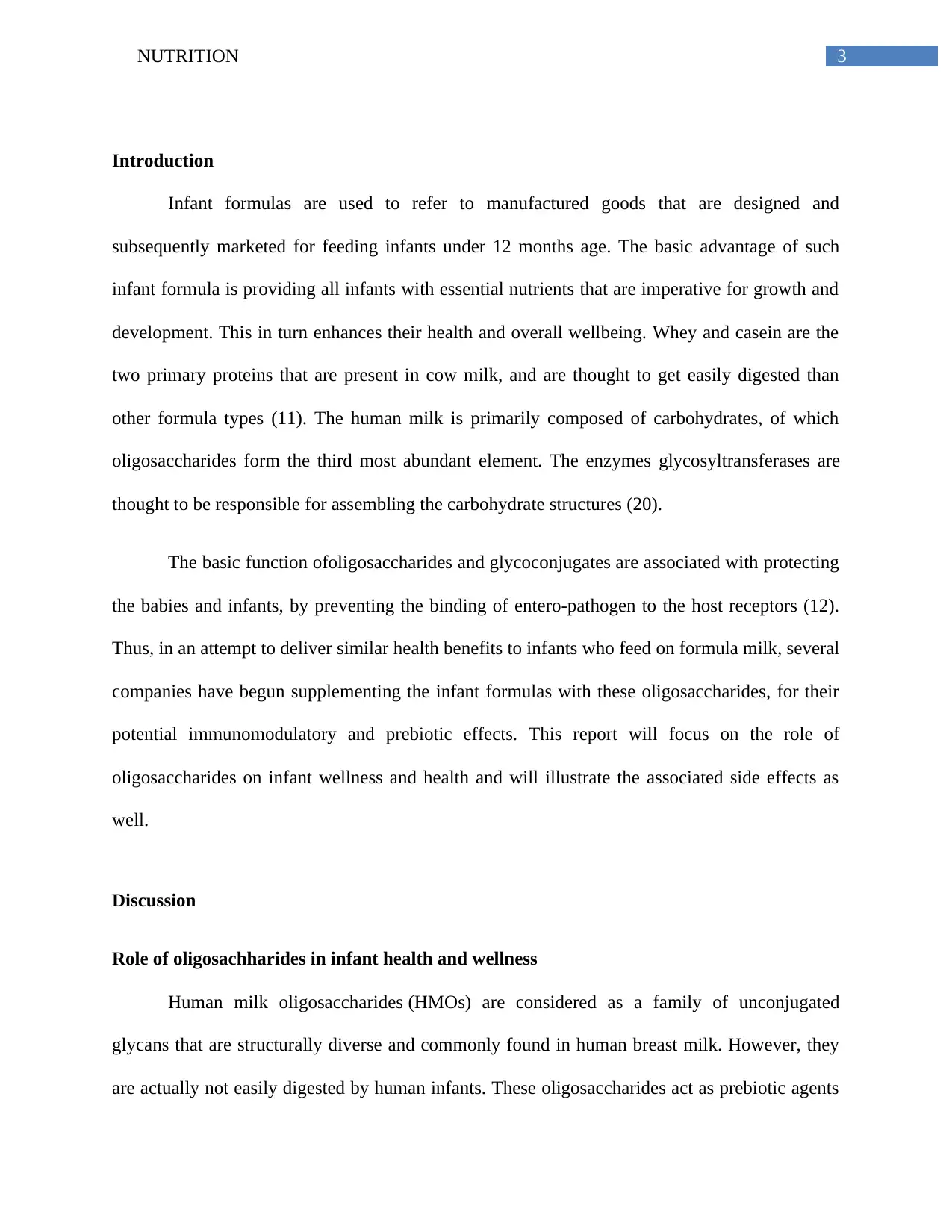
3NUTRITION
Introduction
Infant formulas are used to refer to manufactured goods that are designed and
subsequently marketed for feeding infants under 12 months age. The basic advantage of such
infant formula is providing all infants with essential nutrients that are imperative for growth and
development. This in turn enhances their health and overall wellbeing. Whey and casein are the
two primary proteins that are present in cow milk, and are thought to get easily digested than
other formula types (11). The human milk is primarily composed of carbohydrates, of which
oligosaccharides form the third most abundant element. The enzymes glycosyltransferases are
thought to be responsible for assembling the carbohydrate structures (20).
The basic function ofoligosaccharides and glycoconjugates are associated with protecting
the babies and infants, by preventing the binding of entero-pathogen to the host receptors (12).
Thus, in an attempt to deliver similar health benefits to infants who feed on formula milk, several
companies have begun supplementing the infant formulas with these oligosaccharides, for their
potential immunomodulatory and prebiotic effects. This report will focus on the role of
oligosaccharides on infant wellness and health and will illustrate the associated side effects as
well.
Discussion
Role of oligosachharides in infant health and wellness
Human milk oligosaccharides (HMOs) are considered as a family of unconjugated
glycans that are structurally diverse and commonly found in human breast milk. However, they
are actually not easily digested by human infants. These oligosaccharides act as prebiotic agents
Introduction
Infant formulas are used to refer to manufactured goods that are designed and
subsequently marketed for feeding infants under 12 months age. The basic advantage of such
infant formula is providing all infants with essential nutrients that are imperative for growth and
development. This in turn enhances their health and overall wellbeing. Whey and casein are the
two primary proteins that are present in cow milk, and are thought to get easily digested than
other formula types (11). The human milk is primarily composed of carbohydrates, of which
oligosaccharides form the third most abundant element. The enzymes glycosyltransferases are
thought to be responsible for assembling the carbohydrate structures (20).
The basic function ofoligosaccharides and glycoconjugates are associated with protecting
the babies and infants, by preventing the binding of entero-pathogen to the host receptors (12).
Thus, in an attempt to deliver similar health benefits to infants who feed on formula milk, several
companies have begun supplementing the infant formulas with these oligosaccharides, for their
potential immunomodulatory and prebiotic effects. This report will focus on the role of
oligosaccharides on infant wellness and health and will illustrate the associated side effects as
well.
Discussion
Role of oligosachharides in infant health and wellness
Human milk oligosaccharides (HMOs) are considered as a family of unconjugated
glycans that are structurally diverse and commonly found in human breast milk. However, they
are actually not easily digested by human infants. These oligosaccharides act as prebiotic agents
Secure Best Marks with AI Grader
Need help grading? Try our AI Grader for instant feedback on your assignments.
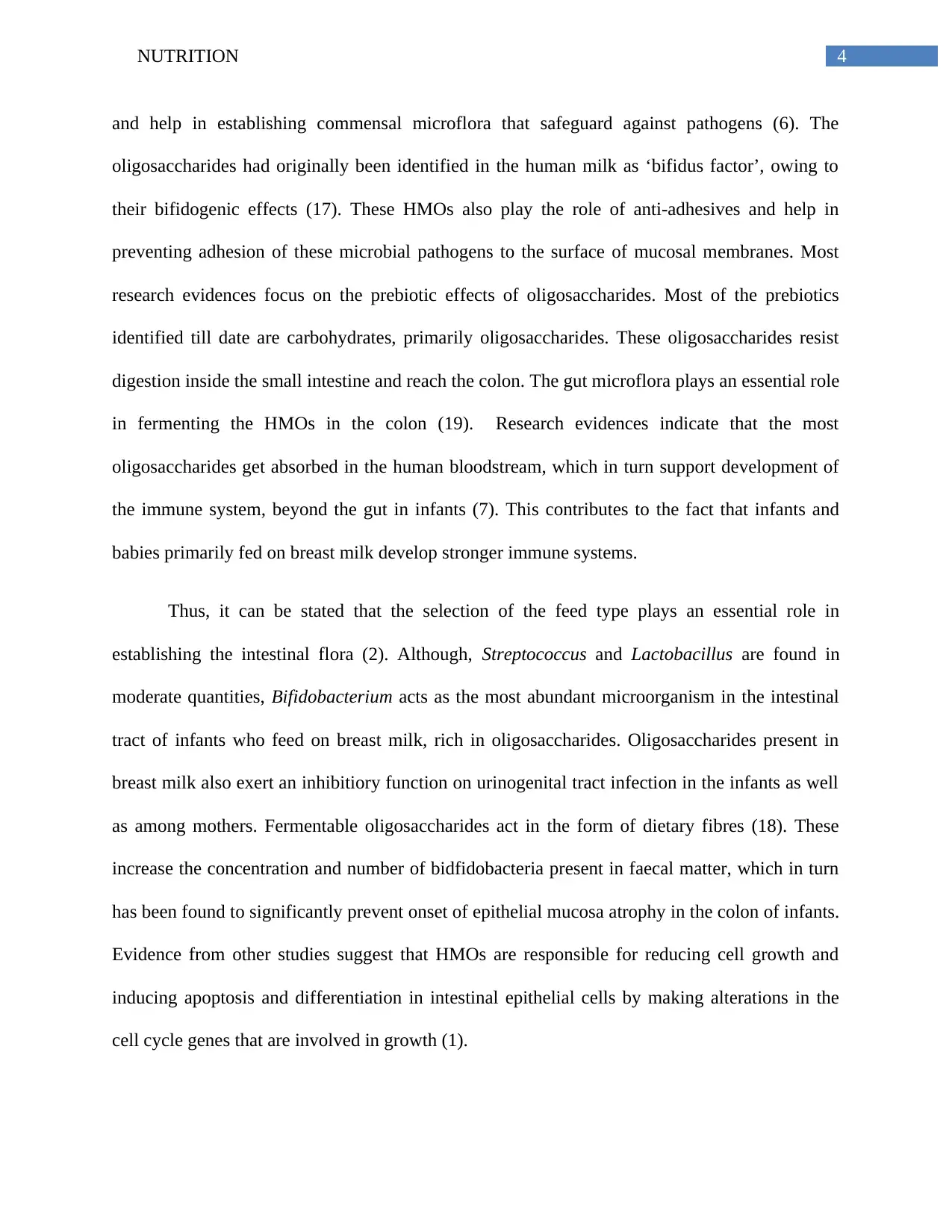
4NUTRITION
and help in establishing commensal microflora that safeguard against pathogens (6). The
oligosaccharides had originally been identified in the human milk as ‘bifidus factor’, owing to
their bifidogenic effects (17). These HMOs also play the role of anti-adhesives and help in
preventing adhesion of these microbial pathogens to the surface of mucosal membranes. Most
research evidences focus on the prebiotic effects of oligosaccharides. Most of the prebiotics
identified till date are carbohydrates, primarily oligosaccharides. These oligosaccharides resist
digestion inside the small intestine and reach the colon. The gut microflora plays an essential role
in fermenting the HMOs in the colon (19). Research evidences indicate that the most
oligosaccharides get absorbed in the human bloodstream, which in turn support development of
the immune system, beyond the gut in infants (7). This contributes to the fact that infants and
babies primarily fed on breast milk develop stronger immune systems.
Thus, it can be stated that the selection of the feed type plays an essential role in
establishing the intestinal flora (2). Although, Streptococcus and Lactobacillus are found in
moderate quantities, Bifidobacterium acts as the most abundant microorganism in the intestinal
tract of infants who feed on breast milk, rich in oligosaccharides. Oligosaccharides present in
breast milk also exert an inhibitiory function on urinogenital tract infection in the infants as well
as among mothers. Fermentable oligosaccharides act in the form of dietary fibres (18). These
increase the concentration and number of bidfidobacteria present in faecal matter, which in turn
has been found to significantly prevent onset of epithelial mucosa atrophy in the colon of infants.
Evidence from other studies suggest that HMOs are responsible for reducing cell growth and
inducing apoptosis and differentiation in intestinal epithelial cells by making alterations in the
cell cycle genes that are involved in growth (1).
and help in establishing commensal microflora that safeguard against pathogens (6). The
oligosaccharides had originally been identified in the human milk as ‘bifidus factor’, owing to
their bifidogenic effects (17). These HMOs also play the role of anti-adhesives and help in
preventing adhesion of these microbial pathogens to the surface of mucosal membranes. Most
research evidences focus on the prebiotic effects of oligosaccharides. Most of the prebiotics
identified till date are carbohydrates, primarily oligosaccharides. These oligosaccharides resist
digestion inside the small intestine and reach the colon. The gut microflora plays an essential role
in fermenting the HMOs in the colon (19). Research evidences indicate that the most
oligosaccharides get absorbed in the human bloodstream, which in turn support development of
the immune system, beyond the gut in infants (7). This contributes to the fact that infants and
babies primarily fed on breast milk develop stronger immune systems.
Thus, it can be stated that the selection of the feed type plays an essential role in
establishing the intestinal flora (2). Although, Streptococcus and Lactobacillus are found in
moderate quantities, Bifidobacterium acts as the most abundant microorganism in the intestinal
tract of infants who feed on breast milk, rich in oligosaccharides. Oligosaccharides present in
breast milk also exert an inhibitiory function on urinogenital tract infection in the infants as well
as among mothers. Fermentable oligosaccharides act in the form of dietary fibres (18). These
increase the concentration and number of bidfidobacteria present in faecal matter, which in turn
has been found to significantly prevent onset of epithelial mucosa atrophy in the colon of infants.
Evidence from other studies suggest that HMOs are responsible for reducing cell growth and
inducing apoptosis and differentiation in intestinal epithelial cells by making alterations in the
cell cycle genes that are involved in growth (1).
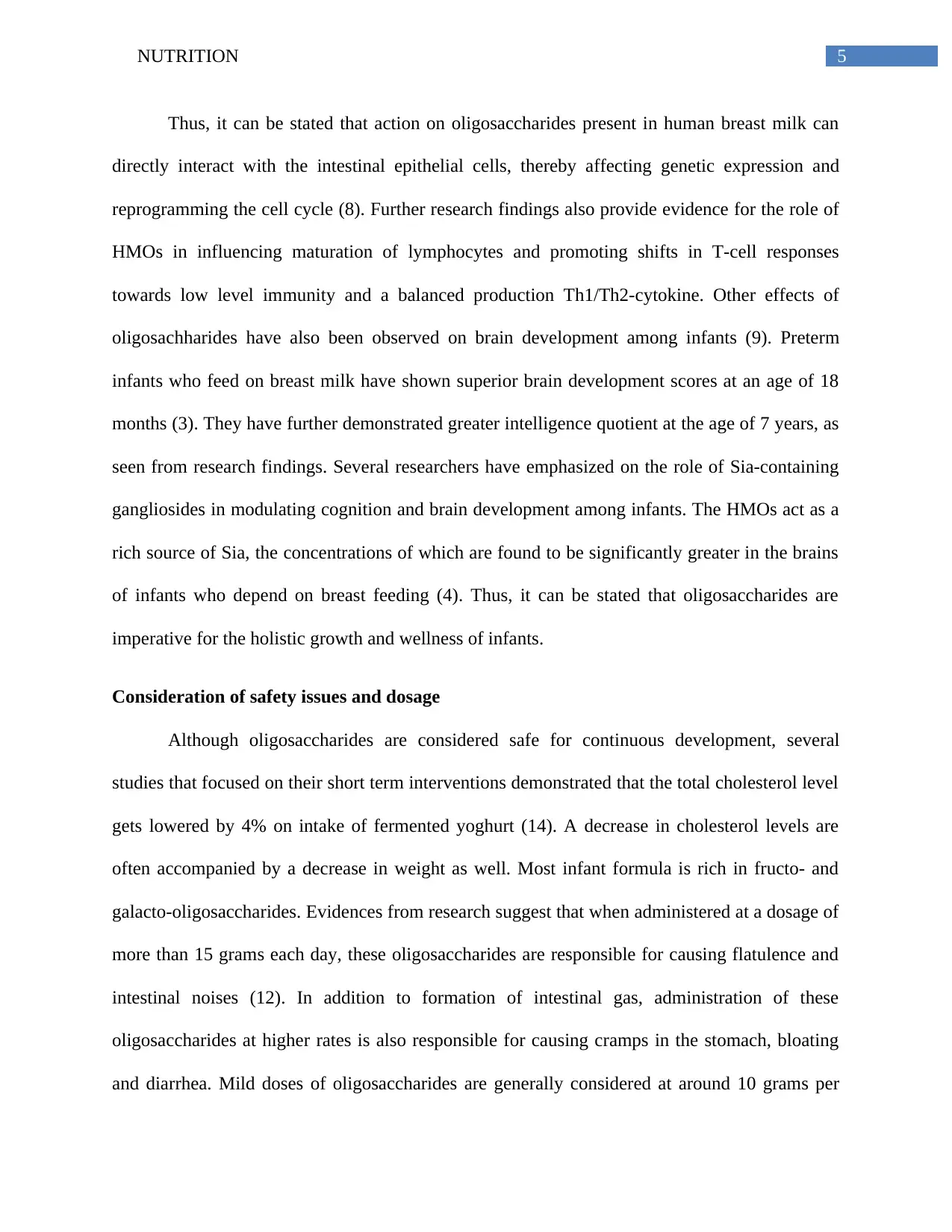
5NUTRITION
Thus, it can be stated that action on oligosaccharides present in human breast milk can
directly interact with the intestinal epithelial cells, thereby affecting genetic expression and
reprogramming the cell cycle (8). Further research findings also provide evidence for the role of
HMOs in influencing maturation of lymphocytes and promoting shifts in T-cell responses
towards low level immunity and a balanced production Th1/Th2-cytokine. Other effects of
oligosachharides have also been observed on brain development among infants (9). Preterm
infants who feed on breast milk have shown superior brain development scores at an age of 18
months (3). They have further demonstrated greater intelligence quotient at the age of 7 years, as
seen from research findings. Several researchers have emphasized on the role of Sia-containing
gangliosides in modulating cognition and brain development among infants. The HMOs act as a
rich source of Sia, the concentrations of which are found to be significantly greater in the brains
of infants who depend on breast feeding (4). Thus, it can be stated that oligosaccharides are
imperative for the holistic growth and wellness of infants.
Consideration of safety issues and dosage
Although oligosaccharides are considered safe for continuous development, several
studies that focused on their short term interventions demonstrated that the total cholesterol level
gets lowered by 4% on intake of fermented yoghurt (14). A decrease in cholesterol levels are
often accompanied by a decrease in weight as well. Most infant formula is rich in fructo- and
galacto-oligosaccharides. Evidences from research suggest that when administered at a dosage of
more than 15 grams each day, these oligosaccharides are responsible for causing flatulence and
intestinal noises (12). In addition to formation of intestinal gas, administration of these
oligosaccharides at higher rates is also responsible for causing cramps in the stomach, bloating
and diarrhea. Mild doses of oligosaccharides are generally considered at around 10 grams per
Thus, it can be stated that action on oligosaccharides present in human breast milk can
directly interact with the intestinal epithelial cells, thereby affecting genetic expression and
reprogramming the cell cycle (8). Further research findings also provide evidence for the role of
HMOs in influencing maturation of lymphocytes and promoting shifts in T-cell responses
towards low level immunity and a balanced production Th1/Th2-cytokine. Other effects of
oligosachharides have also been observed on brain development among infants (9). Preterm
infants who feed on breast milk have shown superior brain development scores at an age of 18
months (3). They have further demonstrated greater intelligence quotient at the age of 7 years, as
seen from research findings. Several researchers have emphasized on the role of Sia-containing
gangliosides in modulating cognition and brain development among infants. The HMOs act as a
rich source of Sia, the concentrations of which are found to be significantly greater in the brains
of infants who depend on breast feeding (4). Thus, it can be stated that oligosaccharides are
imperative for the holistic growth and wellness of infants.
Consideration of safety issues and dosage
Although oligosaccharides are considered safe for continuous development, several
studies that focused on their short term interventions demonstrated that the total cholesterol level
gets lowered by 4% on intake of fermented yoghurt (14). A decrease in cholesterol levels are
often accompanied by a decrease in weight as well. Most infant formula is rich in fructo- and
galacto-oligosaccharides. Evidences from research suggest that when administered at a dosage of
more than 15 grams each day, these oligosaccharides are responsible for causing flatulence and
intestinal noises (12). In addition to formation of intestinal gas, administration of these
oligosaccharides at higher rates is also responsible for causing cramps in the stomach, bloating
and diarrhea. Mild doses of oligosaccharides are generally considered at around 10 grams per
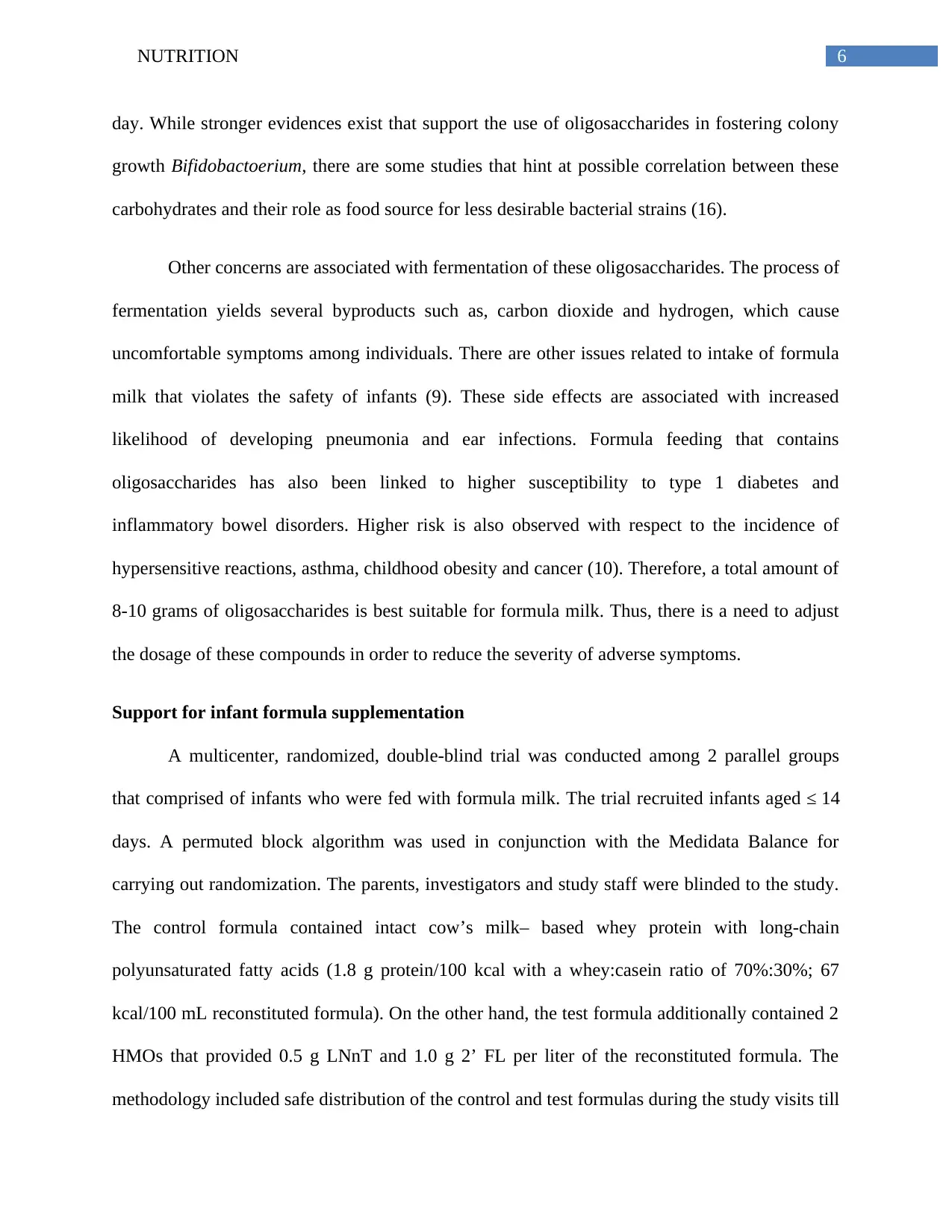
6NUTRITION
day. While stronger evidences exist that support the use of oligosaccharides in fostering colony
growth Bifidobactoerium, there are some studies that hint at possible correlation between these
carbohydrates and their role as food source for less desirable bacterial strains (16).
Other concerns are associated with fermentation of these oligosaccharides. The process of
fermentation yields several byproducts such as, carbon dioxide and hydrogen, which cause
uncomfortable symptoms among individuals. There are other issues related to intake of formula
milk that violates the safety of infants (9). These side effects are associated with increased
likelihood of developing pneumonia and ear infections. Formula feeding that contains
oligosaccharides has also been linked to higher susceptibility to type 1 diabetes and
inflammatory bowel disorders. Higher risk is also observed with respect to the incidence of
hypersensitive reactions, asthma, childhood obesity and cancer (10). Therefore, a total amount of
8-10 grams of oligosaccharides is best suitable for formula milk. Thus, there is a need to adjust
the dosage of these compounds in order to reduce the severity of adverse symptoms.
Support for infant formula supplementation
A multicenter, randomized, double-blind trial was conducted among 2 parallel groups
that comprised of infants who were fed with formula milk. The trial recruited infants aged ≤ 14
days. A permuted block algorithm was used in conjunction with the Medidata Balance for
carrying out randomization. The parents, investigators and study staff were blinded to the study.
The control formula contained intact cow’s milk– based whey protein with long-chain
polyunsaturated fatty acids (1.8 g protein/100 kcal with a whey:casein ratio of 70%:30%; 67
kcal/100 mL reconstituted formula). On the other hand, the test formula additionally contained 2
HMOs that provided 0.5 g LNnT and 1.0 g 2’ FL per liter of the reconstituted formula. The
methodology included safe distribution of the control and test formulas during the study visits till
day. While stronger evidences exist that support the use of oligosaccharides in fostering colony
growth Bifidobactoerium, there are some studies that hint at possible correlation between these
carbohydrates and their role as food source for less desirable bacterial strains (16).
Other concerns are associated with fermentation of these oligosaccharides. The process of
fermentation yields several byproducts such as, carbon dioxide and hydrogen, which cause
uncomfortable symptoms among individuals. There are other issues related to intake of formula
milk that violates the safety of infants (9). These side effects are associated with increased
likelihood of developing pneumonia and ear infections. Formula feeding that contains
oligosaccharides has also been linked to higher susceptibility to type 1 diabetes and
inflammatory bowel disorders. Higher risk is also observed with respect to the incidence of
hypersensitive reactions, asthma, childhood obesity and cancer (10). Therefore, a total amount of
8-10 grams of oligosaccharides is best suitable for formula milk. Thus, there is a need to adjust
the dosage of these compounds in order to reduce the severity of adverse symptoms.
Support for infant formula supplementation
A multicenter, randomized, double-blind trial was conducted among 2 parallel groups
that comprised of infants who were fed with formula milk. The trial recruited infants aged ≤ 14
days. A permuted block algorithm was used in conjunction with the Medidata Balance for
carrying out randomization. The parents, investigators and study staff were blinded to the study.
The control formula contained intact cow’s milk– based whey protein with long-chain
polyunsaturated fatty acids (1.8 g protein/100 kcal with a whey:casein ratio of 70%:30%; 67
kcal/100 mL reconstituted formula). On the other hand, the test formula additionally contained 2
HMOs that provided 0.5 g LNnT and 1.0 g 2’ FL per liter of the reconstituted formula. The
methodology included safe distribution of the control and test formulas during the study visits till
Paraphrase This Document
Need a fresh take? Get an instant paraphrase of this document with our AI Paraphraser
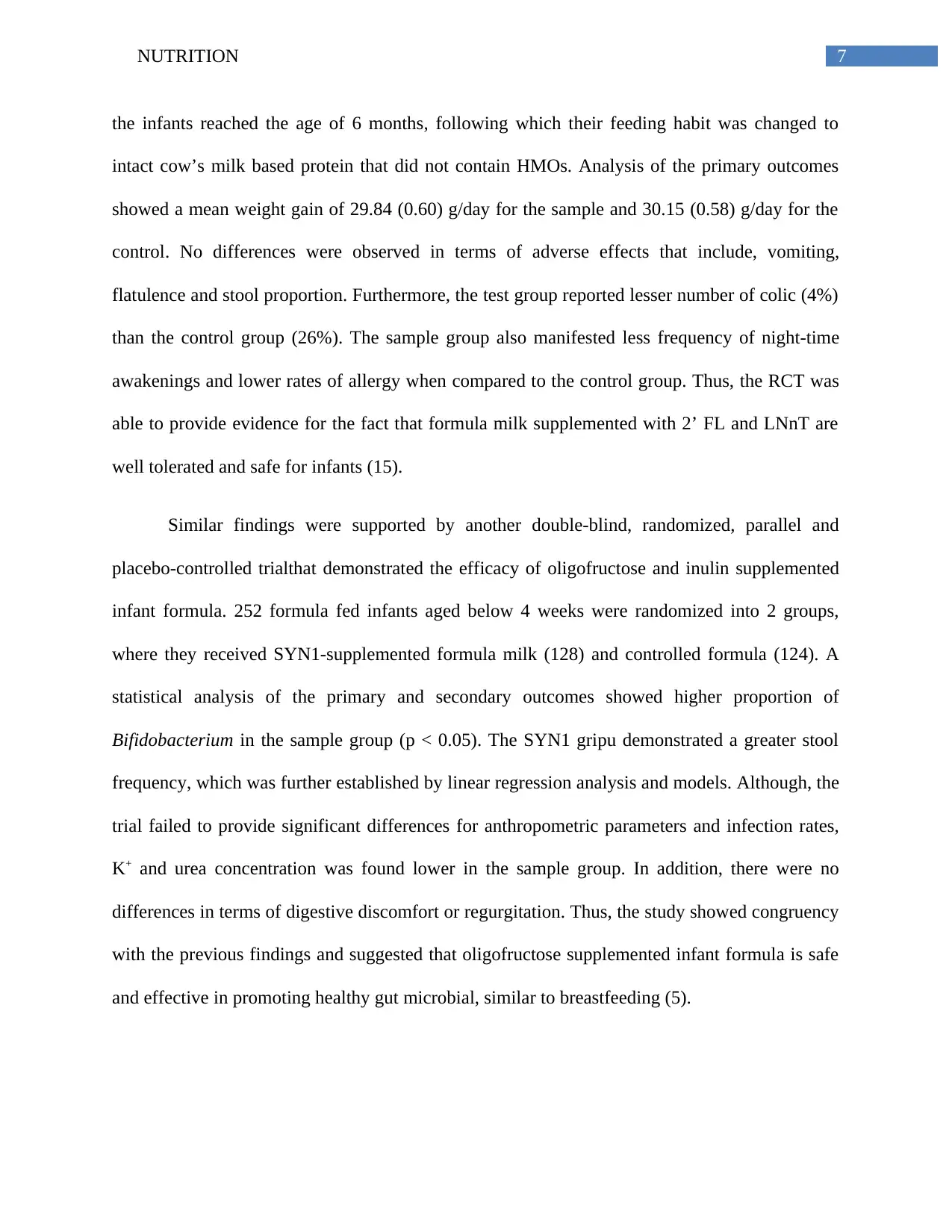
7NUTRITION
the infants reached the age of 6 months, following which their feeding habit was changed to
intact cow’s milk based protein that did not contain HMOs. Analysis of the primary outcomes
showed a mean weight gain of 29.84 (0.60) g/day for the sample and 30.15 (0.58) g/day for the
control. No differences were observed in terms of adverse effects that include, vomiting,
flatulence and stool proportion. Furthermore, the test group reported lesser number of colic (4%)
than the control group (26%). The sample group also manifested less frequency of night-time
awakenings and lower rates of allergy when compared to the control group. Thus, the RCT was
able to provide evidence for the fact that formula milk supplemented with 2’ FL and LNnT are
well tolerated and safe for infants (15).
Similar findings were supported by another double-blind, randomized, parallel and
placebo-controlled trialthat demonstrated the efficacy of oligofructose and inulin supplemented
infant formula. 252 formula fed infants aged below 4 weeks were randomized into 2 groups,
where they received SYN1-supplemented formula milk (128) and controlled formula (124). A
statistical analysis of the primary and secondary outcomes showed higher proportion of
Bifidobacterium in the sample group (p < 0.05). The SYN1 gripu demonstrated a greater stool
frequency, which was further established by linear regression analysis and models. Although, the
trial failed to provide significant differences for anthropometric parameters and infection rates,
K+ and urea concentration was found lower in the sample group. In addition, there were no
differences in terms of digestive discomfort or regurgitation. Thus, the study showed congruency
with the previous findings and suggested that oligofructose supplemented infant formula is safe
and effective in promoting healthy gut microbial, similar to breastfeeding (5).
the infants reached the age of 6 months, following which their feeding habit was changed to
intact cow’s milk based protein that did not contain HMOs. Analysis of the primary outcomes
showed a mean weight gain of 29.84 (0.60) g/day for the sample and 30.15 (0.58) g/day for the
control. No differences were observed in terms of adverse effects that include, vomiting,
flatulence and stool proportion. Furthermore, the test group reported lesser number of colic (4%)
than the control group (26%). The sample group also manifested less frequency of night-time
awakenings and lower rates of allergy when compared to the control group. Thus, the RCT was
able to provide evidence for the fact that formula milk supplemented with 2’ FL and LNnT are
well tolerated and safe for infants (15).
Similar findings were supported by another double-blind, randomized, parallel and
placebo-controlled trialthat demonstrated the efficacy of oligofructose and inulin supplemented
infant formula. 252 formula fed infants aged below 4 weeks were randomized into 2 groups,
where they received SYN1-supplemented formula milk (128) and controlled formula (124). A
statistical analysis of the primary and secondary outcomes showed higher proportion of
Bifidobacterium in the sample group (p < 0.05). The SYN1 gripu demonstrated a greater stool
frequency, which was further established by linear regression analysis and models. Although, the
trial failed to provide significant differences for anthropometric parameters and infection rates,
K+ and urea concentration was found lower in the sample group. In addition, there were no
differences in terms of digestive discomfort or regurgitation. Thus, the study showed congruency
with the previous findings and suggested that oligofructose supplemented infant formula is safe
and effective in promoting healthy gut microbial, similar to breastfeeding (5).
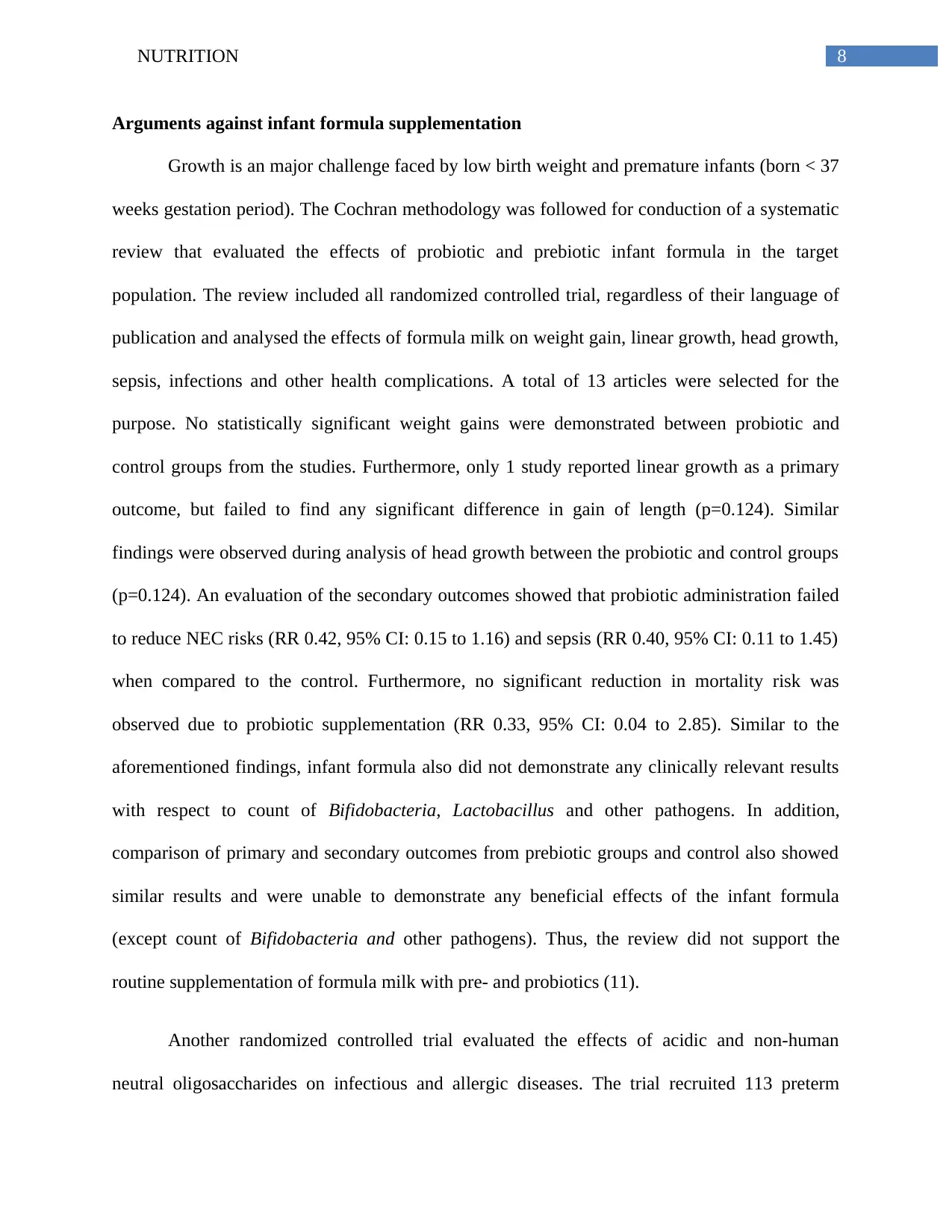
8NUTRITION
Arguments against infant formula supplementation
Growth is an major challenge faced by low birth weight and premature infants (born < 37
weeks gestation period). The Cochran methodology was followed for conduction of a systematic
review that evaluated the effects of probiotic and prebiotic infant formula in the target
population. The review included all randomized controlled trial, regardless of their language of
publication and analysed the effects of formula milk on weight gain, linear growth, head growth,
sepsis, infections and other health complications. A total of 13 articles were selected for the
purpose. No statistically significant weight gains were demonstrated between probiotic and
control groups from the studies. Furthermore, only 1 study reported linear growth as a primary
outcome, but failed to find any significant difference in gain of length (p=0.124). Similar
findings were observed during analysis of head growth between the probiotic and control groups
(p=0.124). An evaluation of the secondary outcomes showed that probiotic administration failed
to reduce NEC risks (RR 0.42, 95% CI: 0.15 to 1.16) and sepsis (RR 0.40, 95% CI: 0.11 to 1.45)
when compared to the control. Furthermore, no significant reduction in mortality risk was
observed due to probiotic supplementation (RR 0.33, 95% CI: 0.04 to 2.85). Similar to the
aforementioned findings, infant formula also did not demonstrate any clinically relevant results
with respect to count of Bifidobacteria, Lactobacillus and other pathogens. In addition,
comparison of primary and secondary outcomes from prebiotic groups and control also showed
similar results and were unable to demonstrate any beneficial effects of the infant formula
(except count of Bifidobacteria and other pathogens). Thus, the review did not support the
routine supplementation of formula milk with pre- and probiotics (11).
Another randomized controlled trial evaluated the effects of acidic and non-human
neutral oligosaccharides on infectious and allergic diseases. The trial recruited 113 preterm
Arguments against infant formula supplementation
Growth is an major challenge faced by low birth weight and premature infants (born < 37
weeks gestation period). The Cochran methodology was followed for conduction of a systematic
review that evaluated the effects of probiotic and prebiotic infant formula in the target
population. The review included all randomized controlled trial, regardless of their language of
publication and analysed the effects of formula milk on weight gain, linear growth, head growth,
sepsis, infections and other health complications. A total of 13 articles were selected for the
purpose. No statistically significant weight gains were demonstrated between probiotic and
control groups from the studies. Furthermore, only 1 study reported linear growth as a primary
outcome, but failed to find any significant difference in gain of length (p=0.124). Similar
findings were observed during analysis of head growth between the probiotic and control groups
(p=0.124). An evaluation of the secondary outcomes showed that probiotic administration failed
to reduce NEC risks (RR 0.42, 95% CI: 0.15 to 1.16) and sepsis (RR 0.40, 95% CI: 0.11 to 1.45)
when compared to the control. Furthermore, no significant reduction in mortality risk was
observed due to probiotic supplementation (RR 0.33, 95% CI: 0.04 to 2.85). Similar to the
aforementioned findings, infant formula also did not demonstrate any clinically relevant results
with respect to count of Bifidobacteria, Lactobacillus and other pathogens. In addition,
comparison of primary and secondary outcomes from prebiotic groups and control also showed
similar results and were unable to demonstrate any beneficial effects of the infant formula
(except count of Bifidobacteria and other pathogens). Thus, the review did not support the
routine supplementation of formula milk with pre- and probiotics (11).
Another randomized controlled trial evaluated the effects of acidic and non-human
neutral oligosaccharides on infectious and allergic diseases. The trial recruited 113 preterm
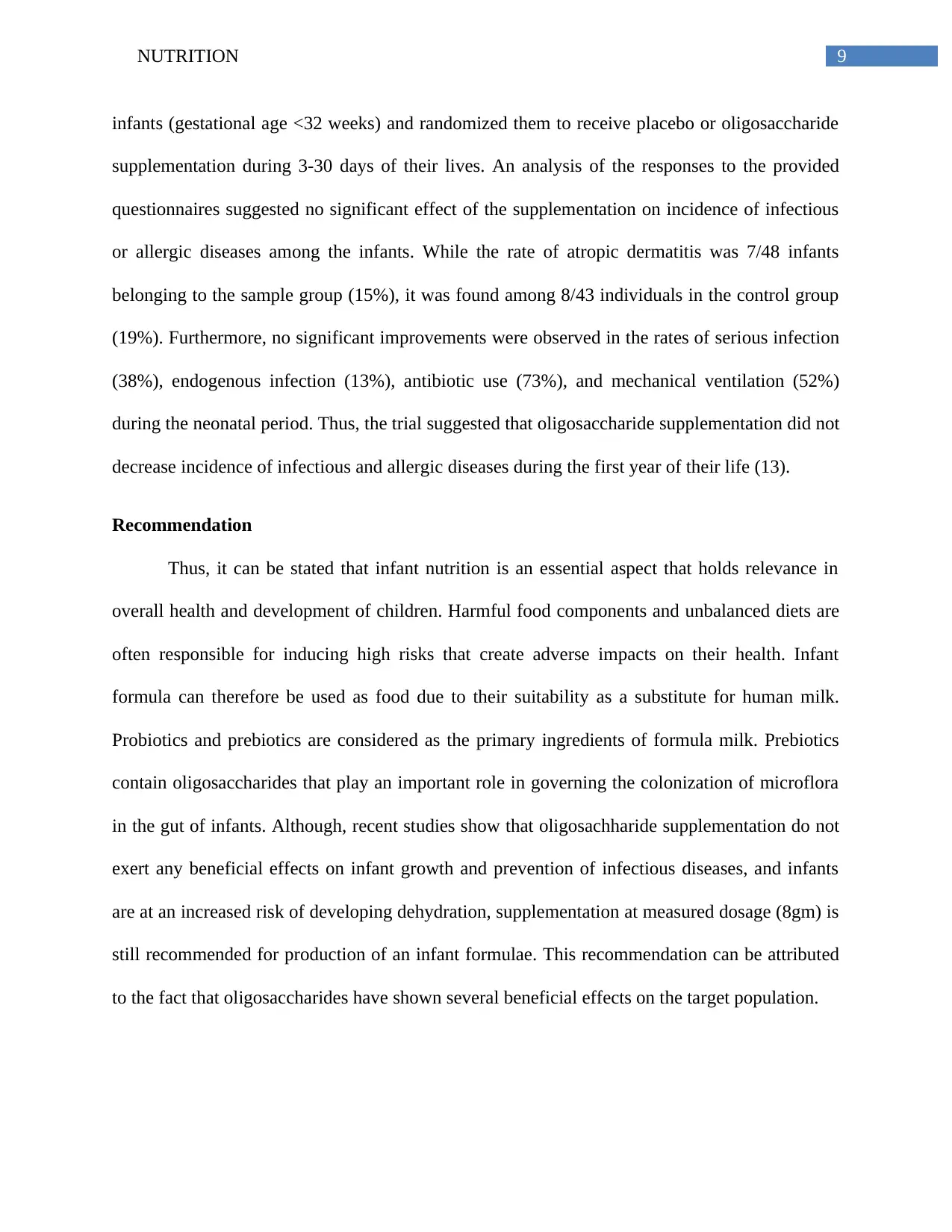
9NUTRITION
infants (gestational age <32 weeks) and randomized them to receive placebo or oligosaccharide
supplementation during 3-30 days of their lives. An analysis of the responses to the provided
questionnaires suggested no significant effect of the supplementation on incidence of infectious
or allergic diseases among the infants. While the rate of atropic dermatitis was 7/48 infants
belonging to the sample group (15%), it was found among 8/43 individuals in the control group
(19%). Furthermore, no significant improvements were observed in the rates of serious infection
(38%), endogenous infection (13%), antibiotic use (73%), and mechanical ventilation (52%)
during the neonatal period. Thus, the trial suggested that oligosaccharide supplementation did not
decrease incidence of infectious and allergic diseases during the first year of their life (13).
Recommendation
Thus, it can be stated that infant nutrition is an essential aspect that holds relevance in
overall health and development of children. Harmful food components and unbalanced diets are
often responsible for inducing high risks that create adverse impacts on their health. Infant
formula can therefore be used as food due to their suitability as a substitute for human milk.
Probiotics and prebiotics are considered as the primary ingredients of formula milk. Prebiotics
contain oligosaccharides that play an important role in governing the colonization of microflora
in the gut of infants. Although, recent studies show that oligosachharide supplementation do not
exert any beneficial effects on infant growth and prevention of infectious diseases, and infants
are at an increased risk of developing dehydration, supplementation at measured dosage (8gm) is
still recommended for production of an infant formulae. This recommendation can be attributed
to the fact that oligosaccharides have shown several beneficial effects on the target population.
infants (gestational age <32 weeks) and randomized them to receive placebo or oligosaccharide
supplementation during 3-30 days of their lives. An analysis of the responses to the provided
questionnaires suggested no significant effect of the supplementation on incidence of infectious
or allergic diseases among the infants. While the rate of atropic dermatitis was 7/48 infants
belonging to the sample group (15%), it was found among 8/43 individuals in the control group
(19%). Furthermore, no significant improvements were observed in the rates of serious infection
(38%), endogenous infection (13%), antibiotic use (73%), and mechanical ventilation (52%)
during the neonatal period. Thus, the trial suggested that oligosaccharide supplementation did not
decrease incidence of infectious and allergic diseases during the first year of their life (13).
Recommendation
Thus, it can be stated that infant nutrition is an essential aspect that holds relevance in
overall health and development of children. Harmful food components and unbalanced diets are
often responsible for inducing high risks that create adverse impacts on their health. Infant
formula can therefore be used as food due to their suitability as a substitute for human milk.
Probiotics and prebiotics are considered as the primary ingredients of formula milk. Prebiotics
contain oligosaccharides that play an important role in governing the colonization of microflora
in the gut of infants. Although, recent studies show that oligosachharide supplementation do not
exert any beneficial effects on infant growth and prevention of infectious diseases, and infants
are at an increased risk of developing dehydration, supplementation at measured dosage (8gm) is
still recommended for production of an infant formulae. This recommendation can be attributed
to the fact that oligosaccharides have shown several beneficial effects on the target population.
Secure Best Marks with AI Grader
Need help grading? Try our AI Grader for instant feedback on your assignments.
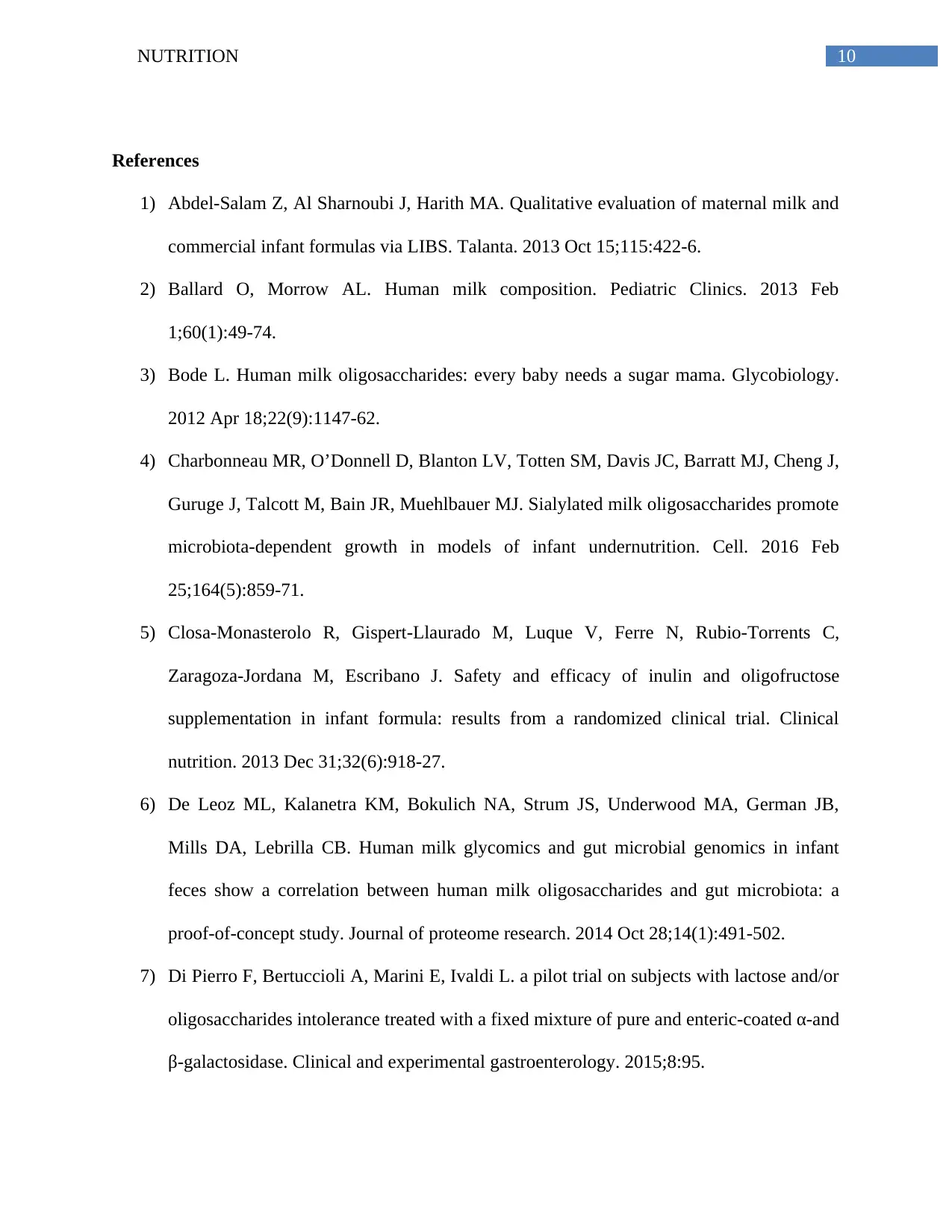
10NUTRITION
References
1) Abdel-Salam Z, Al Sharnoubi J, Harith MA. Qualitative evaluation of maternal milk and
commercial infant formulas via LIBS. Talanta. 2013 Oct 15;115:422-6.
2) Ballard O, Morrow AL. Human milk composition. Pediatric Clinics. 2013 Feb
1;60(1):49-74.
3) Bode L. Human milk oligosaccharides: every baby needs a sugar mama. Glycobiology.
2012 Apr 18;22(9):1147-62.
4) Charbonneau MR, O’Donnell D, Blanton LV, Totten SM, Davis JC, Barratt MJ, Cheng J,
Guruge J, Talcott M, Bain JR, Muehlbauer MJ. Sialylated milk oligosaccharides promote
microbiota-dependent growth in models of infant undernutrition. Cell. 2016 Feb
25;164(5):859-71.
5) Closa-Monasterolo R, Gispert-Llaurado M, Luque V, Ferre N, Rubio-Torrents C,
Zaragoza-Jordana M, Escribano J. Safety and efficacy of inulin and oligofructose
supplementation in infant formula: results from a randomized clinical trial. Clinical
nutrition. 2013 Dec 31;32(6):918-27.
6) De Leoz ML, Kalanetra KM, Bokulich NA, Strum JS, Underwood MA, German JB,
Mills DA, Lebrilla CB. Human milk glycomics and gut microbial genomics in infant
feces show a correlation between human milk oligosaccharides and gut microbiota: a
proof-of-concept study. Journal of proteome research. 2014 Oct 28;14(1):491-502.
7) Di Pierro F, Bertuccioli A, Marini E, Ivaldi L. a pilot trial on subjects with lactose and/or
oligosaccharides intolerance treated with a fixed mixture of pure and enteric-coated α-and
β-galactosidase. Clinical and experimental gastroenterology. 2015;8:95.
References
1) Abdel-Salam Z, Al Sharnoubi J, Harith MA. Qualitative evaluation of maternal milk and
commercial infant formulas via LIBS. Talanta. 2013 Oct 15;115:422-6.
2) Ballard O, Morrow AL. Human milk composition. Pediatric Clinics. 2013 Feb
1;60(1):49-74.
3) Bode L. Human milk oligosaccharides: every baby needs a sugar mama. Glycobiology.
2012 Apr 18;22(9):1147-62.
4) Charbonneau MR, O’Donnell D, Blanton LV, Totten SM, Davis JC, Barratt MJ, Cheng J,
Guruge J, Talcott M, Bain JR, Muehlbauer MJ. Sialylated milk oligosaccharides promote
microbiota-dependent growth in models of infant undernutrition. Cell. 2016 Feb
25;164(5):859-71.
5) Closa-Monasterolo R, Gispert-Llaurado M, Luque V, Ferre N, Rubio-Torrents C,
Zaragoza-Jordana M, Escribano J. Safety and efficacy of inulin and oligofructose
supplementation in infant formula: results from a randomized clinical trial. Clinical
nutrition. 2013 Dec 31;32(6):918-27.
6) De Leoz ML, Kalanetra KM, Bokulich NA, Strum JS, Underwood MA, German JB,
Mills DA, Lebrilla CB. Human milk glycomics and gut microbial genomics in infant
feces show a correlation between human milk oligosaccharides and gut microbiota: a
proof-of-concept study. Journal of proteome research. 2014 Oct 28;14(1):491-502.
7) Di Pierro F, Bertuccioli A, Marini E, Ivaldi L. a pilot trial on subjects with lactose and/or
oligosaccharides intolerance treated with a fixed mixture of pure and enteric-coated α-and
β-galactosidase. Clinical and experimental gastroenterology. 2015;8:95.

11NUTRITION
8) Garrido D, Ruiz-Moyano S, Mills DA. Release and utilization of N-acetyl-D-
glucosamine from human milk oligosaccharides by Bifidobacterium longum subsp.
infantis. Anaerobe. 2012 Aug 31;18(4):430-5.
9) Keunen K, Van Elburg RM, Van Bel F, Benders MJ. Impact of nutrition on brain
development and its neuroprotective implications following preterm birth. Pediatric
research. 2014 Oct 14;77(1-2):148-55.
10) Lönnerdal B. Infant formula and infant nutrition: bioactive proteins of human milk and
implications for composition of infant formulas. The American journal of clinical
nutrition. 2014 Mar 1;99(3):712S-7S.
11) Mugambi MN, Musekiwa A, Lombard M, Young T, Blaauw R. Probiotics, prebiotics
infant formula use in preterm or low birth weight infants: a systematic review. Nutrition
journal. 2012 Aug 28;11(1):58.
12) Neville MC, Anderson SM, McManaman JL, Badger TM, Bunik M, Contractor N,
Crume T, Dabelea D, Donovan SM, Forman N, Frank DN. Lactation and neonatal
nutrition: defining and refining the critical questions. Journal of mammary gland biology
and neoplasia. 2012 Jun 1;17(2):167-88.
13) Niele N, van Zwol A, Westerbeek EA, Lafeber HN, van Elburg RM. Effect of non-
human neutral and acidic oligosaccharides on allergic and infectious diseases in preterm
infants. European journal of pediatrics. 2013 Mar 1;172(3):317-23.
14) Pischetsrieder M, Henle T. Glycation products in infant formulas: chemical, analytical
and physiological aspects. Amino Acids. 2012 Apr 1;42(4):1111-8.
15) Puccio G, Alliet P, Cajozzo C, Janssens E, Corsello G, Sprenger N, Wernimont S, Egli D,
Gosoniu L, Steenhout P. Effects of infant formula with human milk oligosaccharides on
8) Garrido D, Ruiz-Moyano S, Mills DA. Release and utilization of N-acetyl-D-
glucosamine from human milk oligosaccharides by Bifidobacterium longum subsp.
infantis. Anaerobe. 2012 Aug 31;18(4):430-5.
9) Keunen K, Van Elburg RM, Van Bel F, Benders MJ. Impact of nutrition on brain
development and its neuroprotective implications following preterm birth. Pediatric
research. 2014 Oct 14;77(1-2):148-55.
10) Lönnerdal B. Infant formula and infant nutrition: bioactive proteins of human milk and
implications for composition of infant formulas. The American journal of clinical
nutrition. 2014 Mar 1;99(3):712S-7S.
11) Mugambi MN, Musekiwa A, Lombard M, Young T, Blaauw R. Probiotics, prebiotics
infant formula use in preterm or low birth weight infants: a systematic review. Nutrition
journal. 2012 Aug 28;11(1):58.
12) Neville MC, Anderson SM, McManaman JL, Badger TM, Bunik M, Contractor N,
Crume T, Dabelea D, Donovan SM, Forman N, Frank DN. Lactation and neonatal
nutrition: defining and refining the critical questions. Journal of mammary gland biology
and neoplasia. 2012 Jun 1;17(2):167-88.
13) Niele N, van Zwol A, Westerbeek EA, Lafeber HN, van Elburg RM. Effect of non-
human neutral and acidic oligosaccharides on allergic and infectious diseases in preterm
infants. European journal of pediatrics. 2013 Mar 1;172(3):317-23.
14) Pischetsrieder M, Henle T. Glycation products in infant formulas: chemical, analytical
and physiological aspects. Amino Acids. 2012 Apr 1;42(4):1111-8.
15) Puccio G, Alliet P, Cajozzo C, Janssens E, Corsello G, Sprenger N, Wernimont S, Egli D,
Gosoniu L, Steenhout P. Effects of infant formula with human milk oligosaccharides on
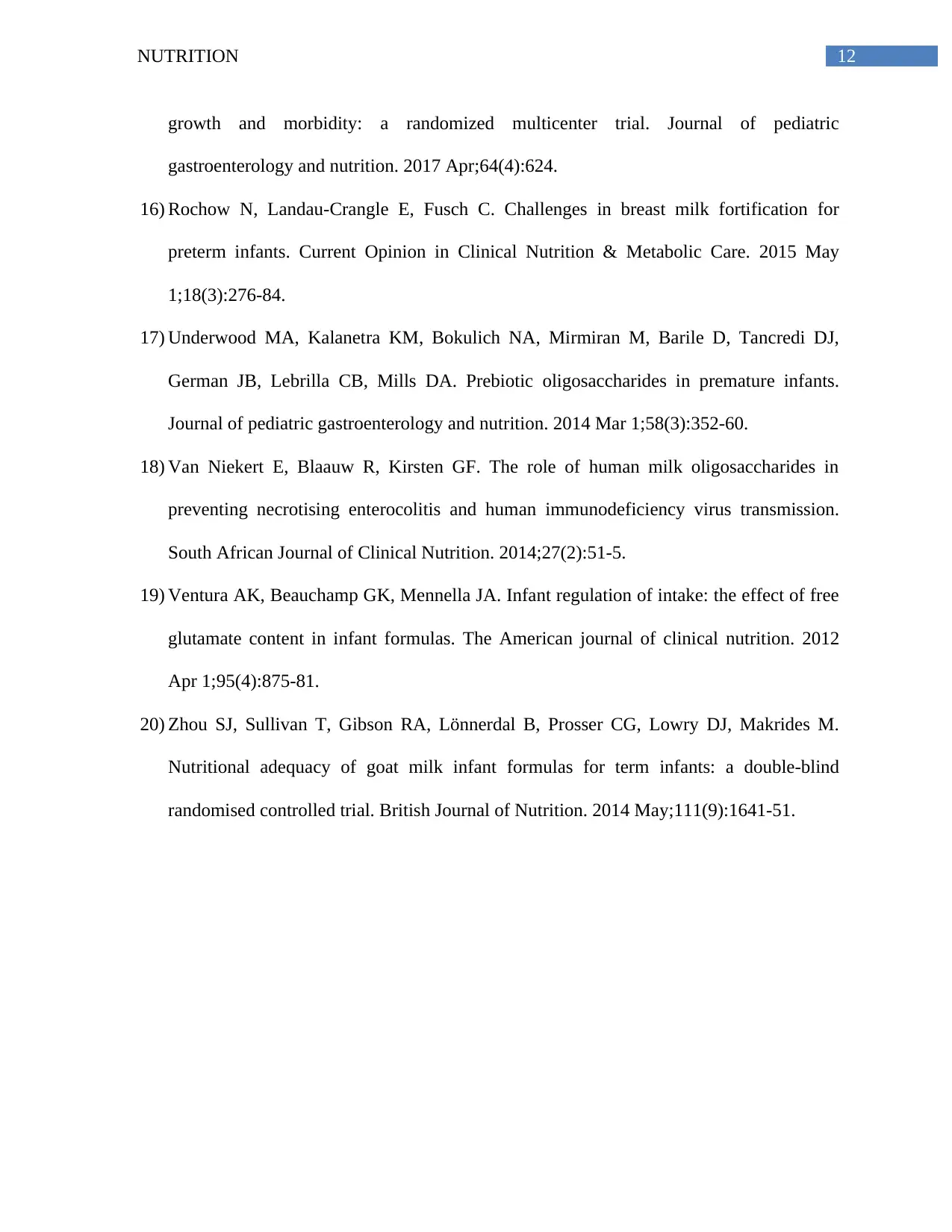
12NUTRITION
growth and morbidity: a randomized multicenter trial. Journal of pediatric
gastroenterology and nutrition. 2017 Apr;64(4):624.
16) Rochow N, Landau-Crangle E, Fusch C. Challenges in breast milk fortification for
preterm infants. Current Opinion in Clinical Nutrition & Metabolic Care. 2015 May
1;18(3):276-84.
17) Underwood MA, Kalanetra KM, Bokulich NA, Mirmiran M, Barile D, Tancredi DJ,
German JB, Lebrilla CB, Mills DA. Prebiotic oligosaccharides in premature infants.
Journal of pediatric gastroenterology and nutrition. 2014 Mar 1;58(3):352-60.
18) Van Niekert E, Blaauw R, Kirsten GF. The role of human milk oligosaccharides in
preventing necrotising enterocolitis and human immunodeficiency virus transmission.
South African Journal of Clinical Nutrition. 2014;27(2):51-5.
19) Ventura AK, Beauchamp GK, Mennella JA. Infant regulation of intake: the effect of free
glutamate content in infant formulas. The American journal of clinical nutrition. 2012
Apr 1;95(4):875-81.
20) Zhou SJ, Sullivan T, Gibson RA, Lönnerdal B, Prosser CG, Lowry DJ, Makrides M.
Nutritional adequacy of goat milk infant formulas for term infants: a double-blind
randomised controlled trial. British Journal of Nutrition. 2014 May;111(9):1641-51.
growth and morbidity: a randomized multicenter trial. Journal of pediatric
gastroenterology and nutrition. 2017 Apr;64(4):624.
16) Rochow N, Landau-Crangle E, Fusch C. Challenges in breast milk fortification for
preterm infants. Current Opinion in Clinical Nutrition & Metabolic Care. 2015 May
1;18(3):276-84.
17) Underwood MA, Kalanetra KM, Bokulich NA, Mirmiran M, Barile D, Tancredi DJ,
German JB, Lebrilla CB, Mills DA. Prebiotic oligosaccharides in premature infants.
Journal of pediatric gastroenterology and nutrition. 2014 Mar 1;58(3):352-60.
18) Van Niekert E, Blaauw R, Kirsten GF. The role of human milk oligosaccharides in
preventing necrotising enterocolitis and human immunodeficiency virus transmission.
South African Journal of Clinical Nutrition. 2014;27(2):51-5.
19) Ventura AK, Beauchamp GK, Mennella JA. Infant regulation of intake: the effect of free
glutamate content in infant formulas. The American journal of clinical nutrition. 2012
Apr 1;95(4):875-81.
20) Zhou SJ, Sullivan T, Gibson RA, Lönnerdal B, Prosser CG, Lowry DJ, Makrides M.
Nutritional adequacy of goat milk infant formulas for term infants: a double-blind
randomised controlled trial. British Journal of Nutrition. 2014 May;111(9):1641-51.
1 out of 13
Related Documents
Your All-in-One AI-Powered Toolkit for Academic Success.
+13062052269
info@desklib.com
Available 24*7 on WhatsApp / Email
![[object Object]](/_next/static/media/star-bottom.7253800d.svg)
Unlock your academic potential
© 2024 | Zucol Services PVT LTD | All rights reserved.
